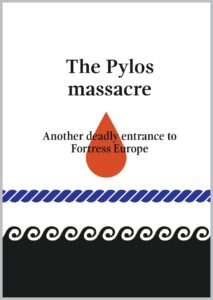 The trial of the Pylos 9 will happen on 21 May in Kalamata. The 9 have been accused of causing the Adriana shipwreck in June 2023, which killed over 600 people. This shipwreck was a massacre carried out by the Hellenic Coast Guard. Yet the Greek state has put these 9 people on trial in an act of misdirection, hiding its own involvement.
The trial of the Pylos 9 will happen on 21 May in Kalamata. The 9 have been accused of causing the Adriana shipwreck in June 2023, which killed over 600 people. This shipwreck was a massacre carried out by the Hellenic Coast Guard. Yet the Greek state has put these 9 people on trial in an act of misdirection, hiding its own involvement.
When the state kills it covers its tracks with post-mortems that attribute cause of death elsewhere: some latent toxin, some foreign body, some other malignancy. The 9 have been identified as the cause of death to make sure we look no further. No state willingly and in good faith investigates its own murderous acts. Knowing this, we undertook a post-mortem ourselves:
- Leaving Libya on 8 June, the Adriana carried 750 people on course to Italy. For days, the Adriana sailed despite a failing engine and short supplies. At least two people had already died on board. After 6 days at sea the Adriana sank leaving only 104 survivors and 82 recovered dead. The others will never be found, trapped inside the boat on the seabed.
- The Adriana’s first distress calls were on the morning of 13 June. The Italian Coast Guard, Frontex, and Alarm Phone told the HCG that the Adriana was in distress in its Search-And-Rescue zone, yet it did nothing until 2pm, when it finally sent a helicopter for observation. At 4pm the HCG sent a vessel from Crete, the LS920, which was too small for purpose. Meanwhile, in nearby Gytheio, a large, fully-equipped rescue ship was moored unused in the port.
- The HCG found the Adriana at 10:40 pm, at which point navigation systems show that it suddenly changed course in the direction of Italy, along with the HCG’s LS920. Its engine stopped at 1:40am. Some time later it inexplicably changed course at speed. How could a boat with a broken engine do this? Survivors say the HCG tied a rope to the Adriana, causing it to sway deeply to one side, swing back to the other, then sink.
- This begs the question: why would you tie a rope to a boat and yank it? Search and rescue professionals say the maneuver is unthinkable, if your objective is to rescue. Maybe this explains why, in the beginning, the HCG denied using the rope until, under the weight of the evidence, they were forced to concede they had done it to try to “stabilise” the Adriana.
This, ultimately, was the cause of death. Though there may have been a number of accomplices – brutal Libyan smuggling mafias, the architects of Europe’s border policies, or the blind-eye turned by its institutions of “justice” – the HCG finished the job. Whether they did it deliberately or had bungled an attempt to drag their victims into Italian jurisdiction, they then fled the scene. For over an hour, merchant and private vessels responded to the shipwreck and found no sign of the HCG. Returning, the HCG made no rescue efforts and over the following days attempted to intimidate those who helped into silence. Meanwhile, undertaking the investigation of their own crimes, the HCG intimidated survivors, manufactured false statements and coerced them into signing.
The HCG and the Greek state are engaged in a cover up. Their actions put their reputation on the line, drawing attention to the shadow pushback policy. Within a day of the sinking 9 survivors were arrested arbitrarily and charged with facilitating illegal entry, causing a shipwreck, building a criminal organization, illegal entry, involuntary manslaughter and endangering the lives of passengers. Their photographs were published in the press, where they were declared guilty pre-trial. Decades of racist imagery of “evil smuggling gangs” conditioned the world to accept that they fit the profile. Yet who are the more likely culprits, those pulled half-dead from the crime scene, or those who made a getaway behind the cover of their masks?
For a more in depth analysis on the subject, you can check out our publication The Pylos Massacre, available in English, Greek, German, French and Farsi.
